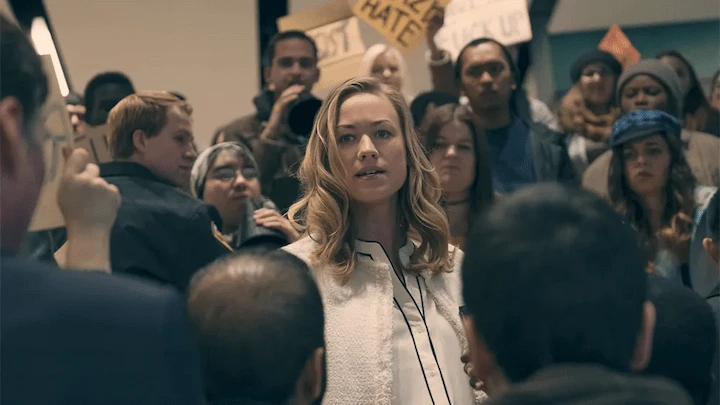Why She Goes Back to Gilead: Power, Survival and the Chains That Bind
In the latest season of The Handmaid’s Tale, Serena Joy Waterford returns to Gilead, despite her previous attempts to escape the oppressive regime. Known as a significant villain, conflicting motivations mark Serena’s character as she navigates her thirst for power and the possibility of redemption in a world she helped create.
Her choices highlight the show’s themes of power dynamics, survival instincts, and how individuals can be trapped in systems they once upheld. As the series concludes, Serena’s return underscores the allure of familiar cycles of power and control, even for those aware of their wrongdoing.
Serena’s Nature: Always an Opportunist
Serena Joy is not another Gilead victim. She helped build it. From the show’s beginning, it becomes clear that Serena was critical in creating the rules that now confine her freedom.
She is depicted on the show as “smart, not dumb.” Contrary to what some viewers might believe, Serena wasn’t tricked into supporting Gilead by her husband Fred. She was instrumental in writing laws that harmed other women. Her actions consistently demonstrate one objective: obtaining power for herself.
What makes Serena interesting is that she can change sides when it works in her favor. She stays when she has the power in Gilead. When that power diminishes, she flies. This repetition across the series exposes the truth of her being.
We see this again in Season 6. She first escapes out of dread of losing her son. Then, Commander Lawrence proposes a unique position for her in New Bethlehem, where people enjoy more freedoms than they do in Gilead. She accepts without resistance and returns. The most telling part? She knows what Gilead did to women like June.
She felt some of it herself. But when offered power again, she ignores all that suffering and climbs back in. And as an observant viewer knows, Serena always puts herself first. Her survival instinct and desire to control every circumstance push all her decisions, warts and all; she’s one of the show’s most complicated figures.
The Power Of Fear And Safety
Many of Serena’s decisions in The Handmaid’s Tale are driven by fear. June fights against Gilead; Serena is often more apt to choose what provides her safety over what is right.
In Season 5, Serena’s fear reaches a crescendo when she believes the Wheelers could “take” her baby. This fear drives her to run away with the help of June. These past foes join forces briefly to find a way out of peril.
But safety in this world is not so simple. In Season 6, Serena returns to Gilead partly because she thinks her son will be safer there. Commander Lawrence assures her that no one will take her child, a powerful promise for a mother.
The show eases into revealing how fear navigates differently in different characters. June’s fears spark more excellent resistance in the fight against Gilead. Serena’s fears also lead her to seek the protection of the very system she once helped create.
And Mrs. Wheeler’s greeting when Serena returns suggests hidden dangers. Her touching Serena’s pregnant belly and quoting scripture tells us Serena could have leapt from one threat to another. But Serena embraces this tangible peril instead of the unknown outside.
We learn how Gilead employs fear as a tactic. It protects with one hand and threatens with the other. For Serena, the devil she knows seems a safer bet than the freedom she has yet to comprehend.
New Bethlehem: Another Trap or Second Chances?
This makes New Bethlehem a narrative fulcrum in the arc of Serena’s return. It is not precisely Gilead but a milder country where women can read and write—freedoms denied in core Gilead territories.
When Commander Lawrence (Bradley Whitford) asks Serena to join him in building New Bethlehem, he’s offering her something potent: Purpose. After being adrift and scared, Serena now has an opportunity to help mold something new. That opportunity is too tempting to turn down.
If there is one question the show asks that is important in life, it is this: Can a lousy system be repaired from the inside? Serena may think making New Bethlehem better than Gilead is possible. She may take this as a chance to right past wrongs.
Yet, history in the show points to caution. New Bethlehem could well be Gilead in a new coat of paint. Like its predecessor, it aims to bring refugees back under Gilead’s control rather than genuinely liberate anyone.
Lawrence’s offer to Serena comes at such a moment, and much about Serena is revealed in the scene. At the mere mention of having influence again, her eyes light up. She doesn’t inquire about the rights or safety of other women—only about her standing and her son.
For viewers, New Bethlehem is built for suspense. Will Serena capitalize on this opportunity to benefit others or herself alone? Her recent history points to the latter, but her character development provides for some surprise.
The Symbolic Link That Binds Serena To Gilead
Through potent sy. Thisrena’s story. Fleetwood Mac, through potent symbols in “The Chain” (0:06), Serena arrives at the Wheeler house in Season 5, Episode 2. The lyrics “never break the chain” repeats, illustrating that Serena is still chained to Gilead, despite how far she runs.
But this chain is made of several things. First, it explains how Serena’s past actions are tied to her present. She helped shape the chains of Gilead, and now she wears them, too.
Second, it makes clear the difficulty of escaping from such systems. Even when Gilead’s flaws become apparent to Serena, and she manages to escape, even temporarily, the chain drags her back. Her identity, her power, and her sense of purpose are all linked to Gilead.
This is where the difference between June and Serena clicks the most. June struggles every hour to escape her shackles. She carries scars from this battle but continues trying. Serena, by contrast, sometimes chooses to embrace her chains when they afford her prestige or security.
When Mrs. Wheeler greets her return, Serena’s expression goes from relief to concern as the camera catches it. And maybe at that moment, she can know she is still shackled, just now in a different home.
The power she seeks, however, has golden handcuffs. For viewers, Serena’s chain is a cautionary tale of how systems ensnare even their creators. No one remains truly free in Gilead, not even those who constructed its rules.
Is Redemption Within Reach For Serena?
“Can Serena ever come back from this after helping to create Gilead? The show provides no easy answer but suggests some ways forward. In seasons 5 and 6, we see glimmers of regret in Serena. Her release with June awakens her to at least some of Gilead’s horrors.
Her pregnancy gives her insight into what the handmaids endure. Some moments hint she may be changing. Serena says she returns to New Bethlehem to help things improve. There, she mentions women being permitted to read — a right she once held dear. If true, this could be the start of her redemption arc.
But the series reminds us words alone do not result in redemption. It requires action and sacrifice. Thus far, Serena has generally operated in self-interest. Given the option to assist others or help herself, she always chooses the latter.
Serena’s relationship with June remains integral to this question. June has seen Serena’s most terrible aspects but also the rarest instances of compassion. Perhaps their fraught connection will ultimately compel Serena to actual change.
For its final season, Serena finds herself at a crossroads. She could leverage her role in New Bethlehem to help women, or she could go after power again. Her decisions will answer whether redemption exists or some shackles can’t be shaken.
Questions on Serena’s Homecoming to Gilead
Why doesn’t Serena leave Gilead, even if she escapes?
Serena returns to Gilead because Commander Lawrence provides her with power, purpose, and protection for her son. So, despite knowing of Gilead’s horrors, she chooses the security and status it gives her over the precariousness of a refugee’s existence.
Is Serena being duped into going back to Gilead?
The show implies that Serena might be walking into a trap. Mrs. Wheeler’s demeanor at Serena’s arrival suggests ulterior motives, specifically regarding Serena’s baby. Yet, she understands Gilead’s deceptions and chooses to go back anyway.
Will Serena wield more power in New Bethlehem than she did in Gilead?
Commander Lawrence offers Serena a role in shaping New Bethlehem — a move that will ultimately pay off disgustingly. Though this implies increased authority compared with when she was a Wife, Gilead’s history indicates that, at best, women can exert limited power that depends on agreement to other subservient roles.
Does Serena still believe in Gilead’s system?
Having lived through Gilead’s limitations herself, Serena’s faith has faltered. However, her belief in the power structure it affords her personally remains. Her return indicates that she prefers position and influence to freedom and equality.
Will Serena and June ever work together again?
Their temporary partnership in fleeing the Wheelers demonstrates that they can work together when there’s a shared threat. But now that Serena is back in Gilead and June is fighting against it, a lasting partnership looks unlikely — unless some dramatic circumstances force them back together again.
Final Words
In The Handmaid’s Tale, Serena Joy’s return to Gilead highlights power, survival, and identity complexities. As the series nears its end, her character stands out as neither a hero nor a villain, illustrating how individuals often make harmful choices to protect themselves.
Her journey emphasizes that true freedom involves the courage to break free from oppressive systems, even when it brings pain. As the series concludes, the question of Serena’s potential redemption raises profound moral dilemmas: What choices would we make when power comes at the expense of others, and can we escape the systems we’ve helped create? Serena’s story encapsulates the show’s deep exploration of power, gender, and resistance in challenging times.
Table of Contents



